
views
Starting Your Flock

Incubate goose eggs for 4 to 5 weeks. The most affordable way to start your flock is to purchase eggs from a reputable hatchery. Large, commercial hatcheries don’t offer the best stock, so check local farm publications or contact your county farm agent to find a reputable supplier. Once you’ve purchased your eggs, you have 2 incubation options: To artificially incubate the eggs, keep them in a forced-air incubator set to 99 to 99.5 °F (37.2 to 37.5 °C) and 60% to 65% relative humidity. Turn the eggs a half turn 3 times per day; stop turning them 2 to 3 days before the end of incubation. For most geese, incubation lasts 28 to 30 days. If you already keep poultry, a broody hen can incubate the eggs naturally. Keep food and water near the nest so the hen doesn’t stray. A hen isn’t large enough to turn the eggs, so you’ll need to do that yourself.
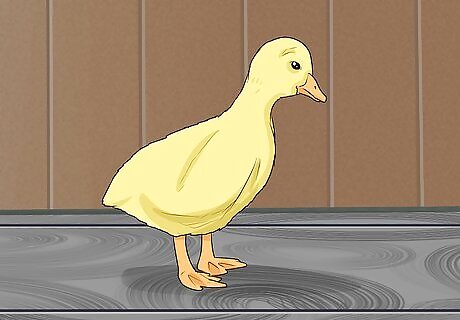
Go with started goslings if you want to skip the incubation period. Look for a reputable breeder in your area who offers day-old goslings. Newly hatched goslings can save you time, but keep in mind you’ll still need to invest in brooding supplies. Goslings should be kept in a pen warmed by a heat lamp for about 5 weeks. Whether you purchase day-old goslings or hatch your own, be sure to spend plenty of time with them during the first few days to imprint yourself on them. Imprinting will make it easier to herd and handle the flock.
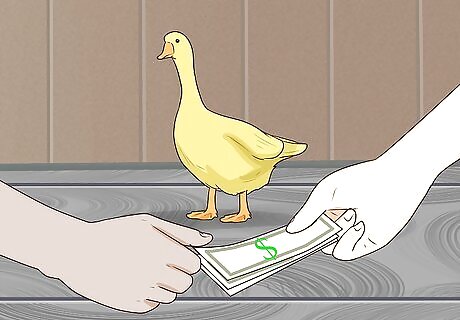
Breed mature geese if you want to handpick your stock. If you're raising geese for exhibition or otherwise need to be selective about your stock, purchase a gander and goose from a reputable breeder. Purchase 2-year old birds in the fall so they’ll be acclimated and ready to mate in the early spring. When choosing mature geese, look for clear eyes and healthy plumage. Check for discharges from the eyes, nose, or mouth, and avoid purchasing obese or underweight birds.Before starting a flock: Check if your local department of agriculture requires permits or licenses for raising geese. Additionally, since geese are vocal, they’re not the best choice if you have neighbors.
Housing Your Birds

House goslings in a heated pen for about 5 weeks. Keep newly hatched goslings in a dry indoor pen. Install a heating lamp and set it at a height of 6 in (15 cm) above the baby birds. Maintain a temperature of 90 °F (32 °C) for the first week, then lower the temperature by 5 to 10 °F (−15 to −12 °C) per week until you’ve reached 70 °F (21 °C). After about 5 weeks, your geese will be hardy and fully-feathered. Keep in mind monitoring the goslings is a better indicator of temperature than a thermometer. If they’re huddled together, the brooding pen is too cold. If they’re trying to get to open areas away from the heat source, it’s too hot. If the weather’s warm, you can take goslings outside for fresh air as early as a week after hatching. Just be sure to keep them dry. Take them out only after morning dew has evaporated and keep them inside on rainy days.

Keep mature geese in a predator-proof shelter overnight. It’s preferable to raise geese on a pasture, but you should still keep them in a secure shed or coop at night. While geese can fend for themselves, they need protection from large predators at night. As a rule of thumb, provide about 6 sq ft (0.56 m) of space per goose. Since they’re hardier than other fowl, they don’t require a sophisticated shelter. Just make sure the enclosure has a secure latch, leak-proof roof, and ventilation. Keep bales of hay inside the shelter for roosting, and line the floor with straw or pine shavings.
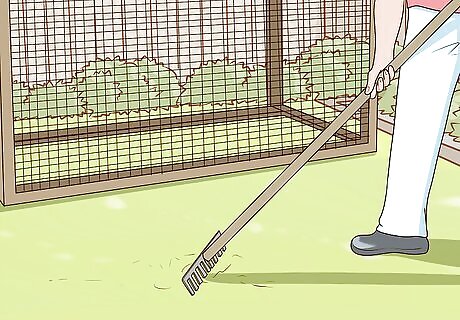
Rake out and replace soiled bedding daily. Roll a wheelbarrow into or just outside of the shelter, and use a pitch fork or rake to remove soiled straw or shavings. Compost the soiled bedding, or use it to mulch around the bases of trees and shrubs.Safety precaution: Wash your hands thoroughly with soap and hot water for 30 seconds after handling the geese or cleaning the enclosure. Geese and other poultry carry salmonella and other germs.
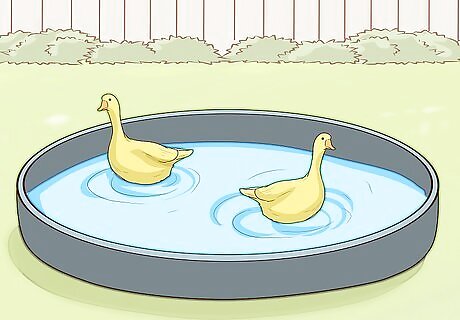
Set up a large container of water if you don’t have a pond. Keep the container outside of the shelter so the bedding doesn’t get wet. It should be about 1 to 2 ft (30 to 61 cm) deep, but not so big that you can’t change the water regularly. Swimming isn’t absolutely necessary, but geese need to submerge their heads in water to keep their nostrils and eyes clean. You’ll need to keep a water source inside the shelter, but make sure it’s small enough that your geese won’t splash around in it.
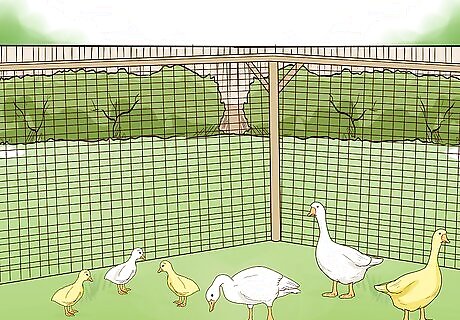
Enclose the flock’s pasture with 5 ft (1.5 m) high fencing. Use heavy-gauge mesh wire and sturdy posts to enclose the flock’s outdoor space. Bury the fence about 6 to 12 in (15 to 30 cm) below the ground to help keep out burrowing predators. Geese aren’t as prone to flying predators as smaller fowl. However, if hawks or owls become a problem, you may need to build a smaller, covered outdoor run to protect your flock.
Providing Food and Water
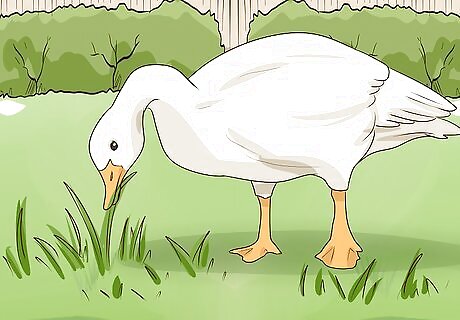
Allow your geese to graze to reduce food cost. Pasturing your geese reduces food cost by about 50%. Adequate food sources include most grasses, with the exception of alfalfa. Before allowing your flock to graze, cut long grass to a height of 4 in (10 cm) to prevent digestive issues. An acre (0.4 hectare) of pasture can support around 20 geese.Flight prevention: Geese have a strong flocking instinct and tend to return home after foraging. However, to prevent strays, clip the first flight feather on one wing every 3 or 4 months.
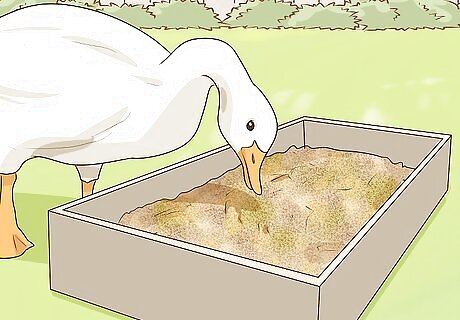
Supplement their diet with geese feed or a mix of grains and seeds. Geese can get most of their dietary needs from grazing. However, you should also keep a feeding trough stocked with geese feed or a mix of cracked corn, oats, wheat, and black oil sunflower seeds. If the pasture is thin and isn't supplying enough nutrition, increase the amount of prepared feed you offer. Place the feed in a sturdy container or trough so the geese can’t knock it over. While it needs to be heavy, make sure it’s small enough that your geese can't jump into it and leave behind droppings. Some geese keepers cut PVC pipe in half and secure it to a wall or fence to make a feeding trough. Commercial geese feed is usually hard to find, but check online or at a local agricultural supplier. If you do purchase store-bought feed, be sure that it’s unmedicated and does not contain coccidiostats. Medicated feed is toxic, especially for goslings.

Ensure your geese have clean water at all times. From goslings to ganders, geese drink large amounts of water. Change their water at least daily or whenever it becomes soiled. Additionally, they need to drink water periodically when they eat, so be sure to keep fresh water by feeding troughs. Keep water close to the trough, but maintain a distance of 3 ft (0.91 m) or so to prevent the food from getting wet and moldy. If they don’t have access to a pond, remember to provide a large container of water so they can clean their nostrils and eyes.

Add a finisher feed to their diet if you’re raising them for meat. If you want to fatten your geese, purchase 15% protein poultry finisher pellets. Look for products online or at agricultural supply stores. Check your product’s instructions and offer the recommended daily amount of food. Provide a continuous supply so the flock can free feed. Geese raised for meat are ready for slaughter after 12 to 14 weeks.




















Comments
0 comment